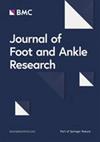Supination resistance variations in foot and ankle musculoskeletal disorders: implications for diagnosis and customised interventions with wedged insoles
IF 2.2
3区 医学
Q1 ORTHOPEDICS
引用次数: 0
Abstract
Supination resistance is a clinical outcome that estimates the amount of external force required to supinate the foot. A greater supination resistance may indicate greater loads on structures responsible for generating internal supination moments across the subtalar joint during static and dynamic tasks. As such, greater supination resistance may be an expected finding in medial foot and ankle musculoskeletal disorders, such as plantar fasciopathy (PF) and posterior tibial tendon dysfunction (PTTD), whereas reduced supination resistance may be present in lateral ankle disorders, such as chronic ankle instability (CAI). However, no studies have yet investigated the changes in supination resistance across these foot and ankle musculoskeletal disorders. This study aimed to quantify supination resistance in individuals with PF, PTTD and CAI compared to healthy controls. Additionally, this study aimed to explore the changes in supination resistance following the simulation of varus and valgus wedges, which are commonly used interventions for these disorders. Fourteen participants with PF, fourteen with PTTD, fourteen with CAI and fourteen healthy controls were recruited. Supination resistance was quantified on a level surface and on a 10-degree inclined surface with varus and valgus positions. Supination resistance was lower for the injured foot for CAI (p < 0.001) and greater for PTTD (p < 0.001) compared to the healthy foot. There was no significant between-foot difference observed for PF (p = 0.275) and controls (p = 0.970). In the injured foot, CAI exhibited lower supination resistance compared to controls (p < 0.001), PF (p = 0.012) and PTTD (p = 0.014). Regardless of the groups, supination resistance increased when tested on a surface with valgus inclination (p < 0.001) and decreased when tested on a surface with varus inclination (p < 0.001). Varus and valgus inclinations to the surface were effective in modifying supination resistance in PTTD and CAI, respectively. Supination resistance seemed unchanged in PF, and thus inclining the standing surface leads to greater between-feet asymmetries. This study also highlights the potential of wedged insoles as a mean to customise treatments and modify tissue stresses in these disorders. The findings contribute to the understanding of foot and ankle biomechanics and may aid in the development of more effective management and rehabilitation strategies.足踝肌肉骨骼疾病中的上翻阻力变化:楔形鞋垫对诊断和定制干预的影响
上翻阻力是一种临床结果,用于估算足部上翻所需的外力大小。上翻阻力越大,表明在静态和动态任务中负责产生整个踝关节内部上翻力矩的结构所承受的负荷越大。因此,在足底筋膜病(PF)和胫骨后肌腱功能障碍(PTTD)等内侧足踝肌肉骨骼疾病中,可能会发现较大的上翻阻力,而在慢性踝关节不稳定(CAI)等外侧足踝疾病中,可能会发现较小的上翻阻力。然而,目前还没有研究对这些足踝肌肉骨骼疾病的上翻阻力变化进行调查。本研究旨在量化与健康对照组相比,PF、PTTD 和 CAI 患者的上翻阻力。此外,本研究还旨在探索模拟变位和外翻楔形后上翻阻力的变化,这是治疗这些疾病的常用干预方法。研究人员招募了 14 名 PF 患者、14 名 PTTD 患者、14 名 CAI 患者和 14 名健康对照者。在水平表面和 10 度倾斜表面上,采用上翻和外翻姿势,对上翻阻力进行量化。与健康足相比,CAI 受伤足的上翻阻力较低(p < 0.001),PTTD 受伤足的上翻阻力较大(p < 0.001)。PF(p = 0.275)和对照组(p = 0.970)的足间差异不明显。与对照组(p < 0.001)、PF 组(p = 0.012)和 PTTD 组(p = 0.014)相比,受伤足的 CAI 显示出较低的上举阻力。无论哪组,当在外翻倾斜表面上进行测试时,上翻阻力都会增加(p < 0.001),而当在曲折倾斜表面上进行测试时,上翻阻力则会降低(p < 0.001)。在 PTTD 和 CAI 中,表面的外翻和内翻分别有效地改变了上翻阻力。PF患者的上翻阻力似乎没有变化,因此倾斜站立面会导致更大的足间不对称。这项研究还强调了楔形鞋垫作为一种定制治疗方法和改变这些疾病的组织应力的潜力。研究结果有助于人们了解足踝生物力学,并有助于制定更有效的管理和康复策略。
本文章由计算机程序翻译,如有差异,请以英文原文为准。
求助全文
约1分钟内获得全文
求助全文
来源期刊

Journal of Foot and Ankle Research
ORTHOPEDICS-
CiteScore
4.50
自引率
10.30%
发文量
83
审稿时长
>12 weeks
期刊介绍:
Journal of Foot and Ankle Research, the official journal of the Australian Podiatry Association and The College of Podiatry (UK), is an open access journal that encompasses all aspects of policy, organisation, delivery and clinical practice related to the assessment, diagnosis, prevention and management of foot and ankle disorders.
Journal of Foot and Ankle Research covers a wide range of clinical subject areas, including diabetology, paediatrics, sports medicine, gerontology and geriatrics, foot surgery, physical therapy, dermatology, wound management, radiology, biomechanics and bioengineering, orthotics and prosthetics, as well the broad areas of epidemiology, policy, organisation and delivery of services related to foot and ankle care.
The journal encourages submissions from all health professionals who manage lower limb conditions, including podiatrists, nurses, physical therapists and physiotherapists, orthopaedists, manual therapists, medical specialists and general medical practitioners, as well as health service researchers concerned with foot and ankle care.
The Australian Podiatry Association and the College of Podiatry (UK) have reserve funds to cover the article-processing charge for manuscripts submitted by its members. Society members can email the appropriate contact at Australian Podiatry Association or The College of Podiatry to obtain the corresponding code to enter on submission.
 求助内容:
求助内容: 应助结果提醒方式:
应助结果提醒方式:


